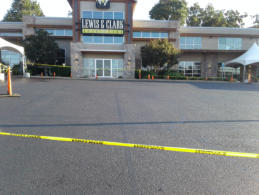ASPHALT SEALING

Sealcoating
The process of sealcoating functions as a weatherproofing skin that extends the life of your pavement. This process protects your asphalt surface from becoming brittle and then becoming subject to softening, unraveling, or shoving. By keeping potholes and divots from forming it not only reduces your liability if an accident occurs, but it greatly reduces the need for more costly asphalt repairs and/or premature replacement. Sealcoating also perfoms the function of a waterproofing membrane which prevents water from filtering into small voids in the asphalt. Once water is allowed into even small voids the freezing and thawing process in the winter will turn small voids into large cracks or pot holes. Sealcoating will fill and level all surface irregularities, giving you a smoother surface which is easier to remove loose sand, dirt, and debris during power sweeping. This barrier that we create also helps to protect asphalt from the water pressure and detergents used in the power washing of driveways or parking spaces. When you have snow or ice it is much easier to remove from a smooth surface. First impressions make a difference after this jet-black sealant is applied, pavement surfaces appear regenerated and beautiful, projecting a positive impression for your company or home. This dark color also absorbs the sun, which causes the surface to become more pliable. This pliability increases its ability to withstand traffic without cracking.Sealcoating Preparation & Application
If you have any structural issues in your asphalt they will still be present after the sealcoat material is applied. Because of this it is important that prior to installation, all structural failures and pavement cracks should be repaired, existing potholes should be milled and replaced, and any oil spots should be removed and primed. It is important to remember that sealcoating is a maintenance procedure, not a repair. When you have newly-laid asphalt, manufacturers recommend the surface be sealcoated sometime after the 90-day curing process is complete and no later than twelve months after installation. For proper maintenance after that, sealcoat should be applied every two to four years depending on external factors such as traffic, wear patterns and weather conditions. According to the manufacturer specifications, sealcoating should only be performed under the proper weather conditions. Air and pavement temperature should be at least 50 degrees Fahrenheit during sealcoat application with no moisture, potential for rain, or freezing temperatures for at least 24 hours. All traffic needs to be stopped on newly sealed pavement for a minimum of 18 to 36 hours after application to allow for curing time. The amount of time will vary depending on the external factors like wind conditions, humidity, sun availability and temperature. If you have an irrigation system it must be deactivated near the area and washing should be suspended for a period of 48 hours before and after work is completed. Sealcoating can be applied in stages in non-adjacent areas to minimize the disruption of traffic to any kind of commercial facility.
479-366-5688
479-366-5688
NWASealCoatLLC@Gmail.com


ASPHALT SEALING



BEFORE
AFTER
479-366-5688
NWASealCoatLLC@Gmail.com

Sealcoating
The process of sealcoating functions as a weatherproofing skin that extends the life of your pavement. This process protects your asphalt surface from becoming brittle and then becoming subject to softening, unraveling, or shoving. By keeping potholes and divots from forming it not only reduces your liability if an accident occurs, but it greatly reduces the need for more costly asphalt repairs and/or premature replacement. Sealcoating also perfoms the function of a waterproofing membrane which prevents water from filtering into small voids in the asphalt. Once water is allowed into even small voids the freezing and thawing process in the winter will turn small voids into large cracks or pot holes. Sealcoating will fill and level all surface irregularities, giving you a smoother surface which is easier to remove loose sand, dirt, and debris during power sweeping. This barrier that we create also helps to protect asphalt from the water pressure and detergents used in the power washing of driveways or parking spaces. When you have snow or ice it is much easier to remove from a smooth surface. First impressions make a difference after this jet-black sealant is applied, pavement surfaces appear regenerated and beautiful, projecting a positive impression for your company or home. This dark color also absorbs the sun, which causes the surface to become more pliable. This pliability increases its ability to withstand traffic without cracking.Sealcoating Preparation
& Application
If you have any structural issues in your asphalt they will still be present after the sealcoat material is applied. Because of this it is important that prior to installation, all structural failures and pavement cracks should be repaired, existing potholes should be milled and replaced, and any oil spots should be removed and primed. It is important to remember that sealcoating is a maintenance procedure, not a repair. When you have newly-laid asphalt, manufacturers recommend the surface be sealcoated sometime after the 90-day curing process is complete and no later than twelve months after installation. For proper maintenance after that, sealcoat should be applied every two to four years depending on external factors such as traffic, wear patterns and weather conditions. According to the manufacturer specifications, sealcoating should only be performed under the proper weather conditions. Air and pavement temperature should be at least 50 degrees Fahrenheit during sealcoat application with no moisture, potential for rain, or freezing temperatures for at least 24 hours. All traffic needs to be stopped on newly sealed pavement for a minimum of 18 to 36 hours after application to allow for curing time. The amount of time will vary depending on the external factors like wind conditions, humidity, sun availability and temperature. If you have an irrigation system it must be deactivated near the area and washing should be suspended for a period of 48 hours before and after work is completed. Sealcoating can be applied in stages in non-adjacent areas to minimize the disruption of traffic to any kind of commercial facility.









